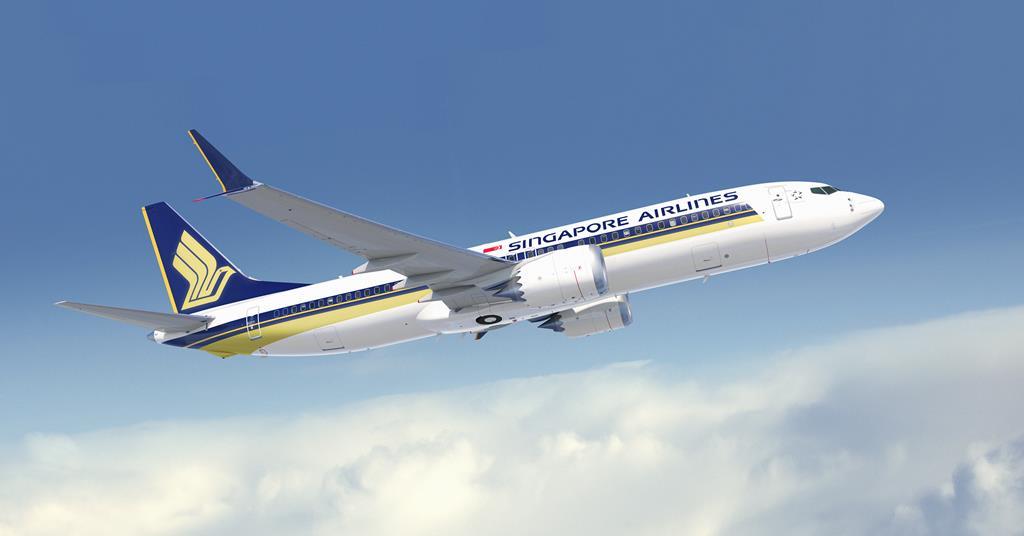Airlines
Why Singapore Airlines Cancels Orders For Eight Boeing 737 MAX 8s

Singapore Airlines Group said that it had canceled orders with Boeing for eight 737-8 passenger aircraft.
The Singapore Airlines Group (SIA) claimed in its most recent annual results declaration that it put an agreement with Boeing for the aircraft order cancellation to satisfy its projected operational needs and its long-term fleet renewal strategy. Singapore Airlines switched three Boeing 787-9s for three bigger 787-10s while canceling the orders for the 737-8s.
In a statement on its full-year results, Singapore Airlines stated that these adjustments “are in line with the group’s long-term fleet renewal strategy, and support its projected operational requirements.” Following these modifications, the group now has 100 aircraft in its book.”
The SIA group has ordered 100 aircraft as a result. Along with three Airbus A350-900s and seven A350Fs, the full-service airline Singapore Airlines has orders for 15 787-10s, 31 777-9s, and 13 737-8s. The LCC arm of SIA, Scoot, has nine Embraer E190-E2s, 12 A320neos, six A321neos, three 787-8s, and one 787-9 on order. To make room for 11 more 777-9s and transfer two 787-9s to Scoot, SIA reduce its order of 787-10s from 44 to 30 in 2021.
Boeing completes Dreamliner family with first 787-10 delivery(Opens in a new browser tab)
According to SIA, the demand in the first quarter of fiscal 2023/24 was strong and was fueled by the rebound in East Asia’s air travel, where advance sales to China, Japan, and South Korea are still high across all classes.
The airline group’s operating profit for the last fiscal year, which concluded on March 31, was SGD $2.69 million ($2 million USD), a record profit for SIA. The airline group also announced an increase in aircraft orders.

Airlines
Air India Rolls Out A350s for Delhi-New York JFK and Newark Routes

In a major development for North American travelers, Air India has announced the deployment of its state-of-the-art Airbus A350-900 aircraft on two key routes: Delhi to New York and Delhi to Newark.
The service on the Delhi-New York route will commence on November 1, 2024, while the Delhi-Newark route will see its inaugural flight on January 2, 2025.
The introduction of the air india a350 will bring significant enhancements to Air India’s offerings, particularly with the launch of its Premium Economy class. air india retrofit This new class will feature 24 wide seats arranged in a 2-4-2 configuration, providing passengers with extra legroom and a more comfortable flying experience.
Soon, Air India aircraft will feature onboard WiFi & all-new cabins: Click here
“We are encouraged by the positive guest feedback we have received from the domestic deployment of our air india a350 interior to offer our hero product on the Delhi-New York JFK and Delhi-Newark routes. This is a significant leap forward for our U.S. operations that also underscores our commitment to continuous improvement,” said Campbell Wilson, Chief Executive Officer & Managing Director of Air India.
The A350’s Business class will set new standards with 28 private suites, each equipped with full-flat beds, direct aisle access, and personal wardrobes. Economy class will be configured to accommodate 264 passengers in a 3-4-3 layout. Across all cabins, passengers will enjoy the latest Panasonic eX3 in-flight entertainment system, offering over 2,200 hours of content.
Air India’s First A350-900: Interior, Routes, &Inflight Features: Click here
This strategic deployment marks a notable enhancement in Air India’s U.S. operations, with 60% of its flights to the U.S. now featuring new or upgraded cabin interiors. The air india new international routes currently operates 51 weekly flights to five U.S. destinations: New York JFK, Newark, Washington DC, Chicago, and San Francisco.
The revamped cabins, advanced in-flight entertainment systems, and improved service standards represent air india wifi commitment to providing a superior travel experience. “We believe this enhanced offering will solidify Air India’s position as a leading carrier and attract travellers seeking a world-class flying experience between India and the United States,” the airline stated.
Seats on these flights are now available for booking on Air India’s website, mobile app, and through travel agents, ensuring that passengers can easily plan their journeys on these newly upgraded routes.
Air India Economy vs Qatar airways economy: which is best?:Click here
-

 Travel1 week ago
Travel1 week agoAir India to Expand US Operations with Three New Routes After a Decade
-

 Travel2 weeks ago
Travel2 weeks agoWhy We Should Avoid These Stamps in a Passport
-

 Airlines1 month ago
Airlines1 month agoInvestigations Reveal Fake Chinese Titanium in Boeing and Airbus Jets
-

 Tech4 weeks ago
Tech4 weeks agoChina’s CATL Plans 1,800-Mile Electric Plane Launch by 2027
-

 Airport3 days ago
Airport3 days agoTop 10 Largest Airports in the World by Size
-

 Aerospace4 weeks ago
Aerospace4 weeks agoChina’s Fighter Jets Turn Wings into Autonomous Drones
-

 Airlines4 days ago
Airlines4 days agoAir India Rolls Out A350s for Delhi-New York JFK and Newark Routes
-

 Defence3 weeks ago
Defence3 weeks agoBoeing Enhances Chinook with New Engines and Block II Upgrades at $96 Million







